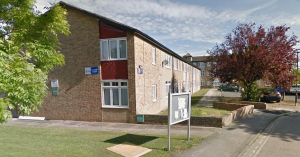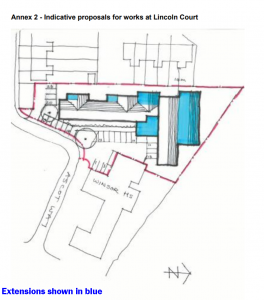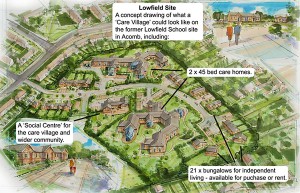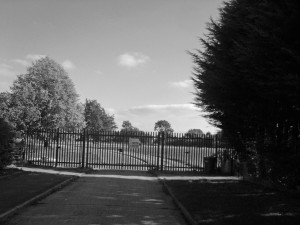
Lincoln Court
Occupants of Lincoln Court had their first chance on Thursday to comment on the Council’s plans to modernise their sheltered accommodation.
In the main, the upgrade plans – which include new kitchens, bathrooms, heating and wiring, new front doors and windows, a new door entry system, roof repairs and external & internal decoration – were welcomed.
However, concern was expressed over the time that residents would be expected to live on a “building site”. This arises out of the proposal to demolish the adjacent Windsor House building and replace it with a centre for the disabled.

Proposed new layout
Residents, most of whom are in their 70’s and 80’s, felt that they could be inconvenienced for as long as three years while the work took place.
It emerged at the meeting that most of the work on Lincoln Court would not be undertaken until the adjacent new building had been completed. This led residents to point out that the noise and dust generated by any demolition process would filter into their living areas because of the inadequacies of the existing doors and windows.
Prior to the meeting the Councils plans to address parking and traffic congestion problems on Ascot Way had been criticised and these issues were raised again by residents. Residents were particularly angry that they might be expected to pay for residents parking permits because of pressure on staff parking. A plan was also needed to address parking needs during the building and modernisation phases.
Residents are also concerned that the existing bus stop – located outside Windsor House – is not shown on the new plans.
One resident went further and said

Hedges blocked view and light from Lincoln Court flats last summer
“The new homes will take away our landing sitting areas, take away all light in the corridors and fill the few outside areas we have. The small, existing garden will not be freely available as we are to become, in effect, a community centre and can only access it via the community room (which is to be in use most of the time). We are also expected to cover all the running costs of the shared facilities as the fuel costs are shared by residents and no charges made to outside departments, clients etc. Even the electricity costs of all the offices and rest areas will be paid by us – we were told that it isn’t a problem at other developments & we can also use facilities! Not good enough”.
Officials have apparently threatened to install security doors on each corridor prompting concerns that the building would resemble a “prison”.
Residents had complained last year about the Councils failure to cut a tall hedge at the rear of the properties. The hedge effectively blocked light from the flats, prompting a feeling of isolation.
The consultation event was dismissed by some as a “paper exercise” and there were calls for a fundamental rethink before planning permission was sought.
Local Councillors are now looking into the issues raised.

 City of York Council and its partners are asking for older people across the city for their views on how we as a city can keep them healthier, happier and more independent for longer.
City of York Council and its partners are asking for older people across the city for their views on how we as a city can keep them healthier, happier and more independent for longer.
